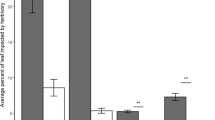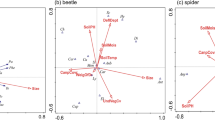Abstract
Plants growing in vegetationally diverse habitats or near taxonomically distinct neighbors often experience less herbivory than plants in more simple habitats. When plants experience more herbivory in these situations it is called associational susceptibility and is most common when herbivores spill from their preferred plant host onto neighboring plants. Cankerworms are common pests of urban trees that have been shown in forests to disperse from preferred to less preferred hosts. I found that two common characteristics of urban habitats, low vegetational diversity and exotic plants, affect cankerworm herbivory of non-host understory plants. In an urban landscape I measured cankerworm herbivory on native dogwood trees growing in the open and below cankerworm host and non-host trees. Herbivory of native dogwoods was ten times greater below cankerworm hosts than on trees below non-hosts or in the open. At an arboretum I measured herbivory of native and exotic plants growing below cankerworm hosts in simple landscape plantings and in natural forests. Associational susceptibility of native dogwoods and Rhododendron spp. disappeared when they were growing in complex natural forests even though cankerworm hosts were more abundant. Cankerworms consistently preferred native plant species more than exotic congeners in laboratory experiments. As such, exotic plants experienced very little herbivory regardless of habitat. Herbivorous pests are often more abundant on urban plants than plants in natural habitats. My research shows that, although some plants experience more herbivory when growing near cankerworm hosts, increasing urban habitat complexity could reduce pest damage overall.




Similar content being viewed by others
References
Andow DA (1991) Vegetational diversity and arthropod population response. Annu Rev Entomol 36:561–586
Atsatt PR, O’Dowd DJ (1976) Plant defense guilds. Science 193:24–29
Baker WL (1972) Eastern Forest Insects. United States Department of Agriculture, Forest Service, Miscellaneous publication no. 1175
Barbosa P, Hines J, Kaplan I, Martinson H, Szczepaniec A, Szendrei Z (2009) Associational resistance and associational susceptibility: having right or wrong neighbors. Ann Rev Ecol Evol Syst 40:1–20
Bernays E, Chapman RF (1994) Host-plant selection by phytophagous insects. Chapman and Hall, New York
Chanthammavong N, Bryant G, Frank S (2014) The effect of sticky bands on cankerworm abundance and defoliation in urban trees. Arboriculture and Urban Forestry
Chase JF, Walsh JJ (2006) Urban effects on native avifauna: a review. Landsc Urban Plan 74:46–49
Cuming FG (1961) The distribution, life history, and economic importance of the winter moth, Operophtera brumata (L.) (Lepidoptera, Geometridae) in Nova Scotia. Can Entomol 93:135-142
Eirich R (2008) Establishing action thresholds for control of cankerworms in Regina, Saskatchewan, Canada. Arboricult Urban For 34:66–73
Fedde FG, Morris CL, Drooz AT (1973) Delayed parasitism of fall cankerworm eggs in Virginia. Environ Entomol 2:1123-1125
Feeny P (1976) Plant apparency and chemical defense. Recent Adv Phytochem 10:1–40
Futuyma DJ, Wasserman SS (1980) Resource concentration and herbivory in oak forests. Science 210:920–922
Grimm NB, Faeth SH, Golubiewski NE, Redman CL, Wu JG, Bai XM, Briggs JM (2008) Global change and the ecology of cities. Science 319:756-760
Hanks LM, Denno RF (1993) Natural enemies and plant water relations influence the distribution of an armored scale insect. Ecology 74:1081–1091
Kareiva P (1983) Influence of vegetation texture on herbivore populations: resource concentration and herbivore movement. In: Denno RF, McClure MS (eds) Variable plants and herbivores in natural and managed ecosystems. Academic, San Diego, pp 259–289
Keane RM, Crawley MJ (2002) Exotic plant invasions and the enemy release hypothesis. Trends Ecol Evol 17:164–170
McDonnell MJ, Pickett STA (1990) Ecosystem structure and function along urban-rural gradients: an unexploited opportunity for ecology. Ecology 71:1232-1237
McKinney M (2002) Urbanization, biodiversity, and conservation. Bioscience 52:883–890
Meineke EK, Dunn RR, Sexton JO, Frank SD (2013) Urban warming drives insect pest abundance on street trees. PLoS ONE 8:e59687
Pimentel D (1961) Species diversity and insect population outbreaks. Ann Entomol Soc Am 54:76-86
Raupp MJ, Noland RM (1984) Implementing landscape plant management programs in institutional and residential settings. J Arboric 10:161–169
Raupp MJ, Holmes JJ, Sadof C, Shrewsbury P, Davidson JA (2001) Effects of cover sprays and residual pesticides on scale insects and natural enemies in urban forests. J Arboric 27:203–215
Raupp MJ, Shrewsbury PM, Herms DA (2010) Ecology of herbivorous arthropods in urban landscapes. Annu Rev Entomol 55:19–38
Riley CV, Packard AS, Thomas C (1883) Canker worms: being an account of the two species injurious to fruit and shade trees, with practical suggestions. Third Report of the United State Entomological Commission. United States Department of Agriculture. Washington, D.C.
Root RB (1973) Organization of a plant-arthropod association in simple and diverse habitats: the fauna of collards (Brassica: Oleracea). Ecol Monogr 43:95–124
SAS (2012) SAS version 9.3. SAS Institute, Cary
Schneider JC (1980) The role of parthenogenesis and female aptery in microgeographic, ecological adaptation in the fall cankerworm, Alsophila pometaria Harris (Lepidoptera: Geometridae). Ecology 61:1082–1090
Shrewsbury PM, Raupp MJ (2000) Evaluation of components of vegetational texture for predicting azalea lace bug, Stephanitis pyrioides (Heteroptera : Tingidae), abundance in managed landscapes. Environ Entomol 29:919–926
Shrewsbury PM, Raupp MJ (2006) Do top-down or bottom-up forces determine Stephanitis pyrioides abundance in urban landscapes? Ecol Appl 16:262–272
Tallamy DW (2004) Do exotic plants reduce insect biomass? Conserv Biol 18:1689–1692
Tooker JF, Hanks LM (2000) Influence of plant community structure on natural enemies of pine needle scale (Homoptera: Diaspididae) in urban landscapes. Environ Entomol 29:1305–1311
Vehviläinen H, Koricheva J, Ruohomaki K (2007) Tree species diversity influences herbivore abundance and damage: meta-analysis of long-term forest experiments. Oecologia 152:287–298
Walker JS, Grimm NB, Briggs JM, Gries C, Dugan L (2009) Effects of urbanization on plant species diversity in central Arizona. Front Ecol Environ 7:465–470
White JA, Whitham TG (2000) Associational susceptibility of cottonwood to box elder herbivore. Ecology 81:1795–1803
Acknowledgments
I first observed cankerworm herbivory patterns at Bartlett Tree Laboratories and Arboretum during the Southern Plant Network Southern Regional Workshop. I am grateful to Casey Sclar, Amanda Hodges, and the Bartlett staff for this opportunity and apologize for sneaking out of the workshop. Greg Bryant and Bobby Chanthammavong helped collect data on campus. Sarah Jandricic, Elsa Youngsteadt, Emily Meineke, Adam Dale, Holden Appler, and Travis McClure, and two anonymous reviewers provided comments to improve the manuscript. This work was supported by a grant from the USDA AFRI (2013-02476) to SDF, and by the NCSU Department of Entomology and the Keck Center for Behavioral Biology. The project described in this publication was supported by Cooperative Agreement No. G11AC20471 and G13AC00405 from the United States Geological Survey. Its contents are solely the responsibility of the authors and do not necessarily represent the views of the Southeast Climate Science Center or the USGS. This manuscript is submitted for publication with the understanding that the United States Government is authorized to reproduce and distribute reprints for Governmental purposes. SDF was also supported by NSF RAPID (1318655) and USDA Southern Region IPM (2010-02678).
Author information
Authors and Affiliations
Corresponding author
Rights and permissions
About this article
Cite this article
Frank, S.D. Bad neighbors: urban habitats increase cankerworm damage to non-host understory plants. Urban Ecosyst 17, 1135–1145 (2014). https://doi.org/10.1007/s11252-014-0368-x
Published:
Issue Date:
DOI: https://doi.org/10.1007/s11252-014-0368-x




